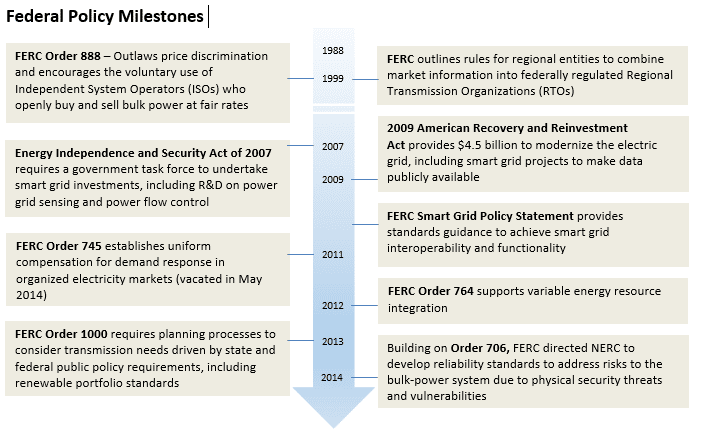Power generation and transmission is undergoing a significant shift and recent activity widely highlights a focus on electricity grid modernization as well as exploration of new decentralized models. Both state and federal efforts show continued support for renewable energy integration, smart grid deployment, and demand response programs with a particular focus on enhancing grid reliability. The Federal Energy Regulatory Commission (FERC) recognizes the changing power landscape, and has issued a series of Orders – 745 (recently vacated), 764, and 1000 – to facilitate different aspects of system operations. The Department of Energy (DOE) and a number of states are exploring microgrid development to address power grid vulnerabilities

New York Reforming the Energy Vision (REV)
The REV initiative – announced by Governor Cuomo in April 2014 – tasks the New York Public Service Commission (PSC) to move the state’s energy sector towards a decentralized, market-based structure. By incorporating distributed generation, demand response, higher levels of renewable energy sources, and greater customer interaction through outreach and technology, REV aims to lower energy costs and create a cleaner, more efficient, and more reliable electric grid. Potential regulatory reforms to realize the REV-envisioned benefits will be examined on two parallel tracks. Track One focuses on utilities’ role for market-based deployment of distributed energy resources to promote load management and system efficiency. The Track One Staff Straw Proposal was issued August 22, with comments due by September 22, 2014. Track Two examines changes in the current regulatory, tariff, market, and incentive structures to better align utility interests. A Track Two Straw Proposal will be issued January 30, 2015, with comments due by March 20.
KEY STATES TO WATCH
| New York | Hawaii | California |
|
The REV initiative aims to move the state’s energy sector towards a decentralized, market-based structure. NY utilities and the NY Independent System Operator (NYISO) are deploying new technologies for state grid modernization, including information tools to manage energy use. The NY Prize competition totals $40 million in awards with the goal of developing at least 10 clean energy community grids and microgrids in 2014. The NY SUN was extended in April 2014 with a $1 billion commitment to add more than 3 gigawatts of installed solar capacity in the State by 2023. |
Hawaiian Electric Companies’ energy action plans proposed in August aim to reduce electric bills by 20 percent, triple distributed solar generation levels, and generate 65 percent electricity from renewables by 2030. The Hawaii PUC’s Inclination on the Future of Hawaii’s Electric Utilities provides grid modernization guidance to better align utilities’ business models with customers’ interests and policy goals. With a DOE grant awarded in June, Hawaii will begin incorporating synchrophasor data into transmission and distribution (T&D) modeling and data analysis for grid modernization. |
In August, The CA PUC instituted rulemaking (R.14-08-013) to incorporate distributed energy resources into planning and operation of distribution systems. AB 327, passed in 2013, requires regulated utilities to file distributed resources plans by 2015. Energy Storage procurement Decision 13-10-040, adopted in October 2013, requires utilities to procure 1,325 MW by 2020 to improve grid operations. The 2015-2017 Electric Program Investment Charge, which fosters innovation for 21st century electric grid, includes the New Solar Homes Partnership. |
Sources: State Legislatures, EnerKnol
Looking Ahead
The power industry is transitioning to a new era of distributed generation and demand-side programs to address grid reliability. Federal policies continue to promote integration of intermittent renewable energy sources through new compensation and scheduling reforms. These efforts are significant for renewable energy as capacity increases with supportive tax credits and state renewable energy portfolio mandates. FERC also is addressing power grid vulnerabilities through new reliability and security standards. In light of these concerns, some jurisdictions are pursuing microgrids as a potential solution to provide increased reliability, economic efficiency, and distributed generation. Continued federal, state, and local pilot programs combined with supportive regional regulations will ensure a sustainable transition to the next era of power generation, transmission, and consumption
Donovan Lazar | Chief Revenue Officer
dl@enerknol.com | 212-537-4797 ext. 8







